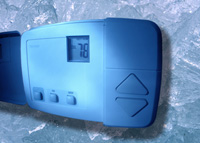
Outside, the temperature fluctuates. This means that inside your house the temperature will fluctuate as well. Setting the thermostat at 70 degrees and never adjusting it can end up wasting a lot of energy. On the other hand, adjusting programmable thermostats too often can also be wasteful, as it forces the HVAC system into frequent starts and stops, accelerating wear and tear. Eight hours is a good stretch of time to let your system stay at one temperature.
Programmable thermostats take away the hassle of manual adjustments and keep your household comfortable — and your utility bills affordable — all day. Just select several temperatures that keep your home comfortable at different times of the day. Don’t forget about the times when no one is home, and at night. For times like these, you can set a temperature that’s several degrees lower than your preferences (or higher, during summer) to save energy. If you happen to get uncomfortable, you can always manually override the program without deleting the program itself.
Which settings are right for your household? Everyone is different. However, here are a few guidelines that may help:
- When running your furnace, 68 degrees should be comfortable when the house is full and busy. The rest of the time, program the device to a setting of 60 degrees.
- When running your air conditioner, 75 degrees should keep the house cool enough when people are home. 80 degrees is a good energy-saving setting, which won’t cause the A/C undue stress to cool the building down again.
Call Rodenhiser Plumbing, Heating & Air Conditioning if you’d like to learn more about programmable thermostats or are thinking of upgrading to one. We’ll help you select the right unit to work in conjunction with your HVAC system. We’ve been serving Massachusetts homeowners since 1928, and would be happy to help keep your home comfortable.
Our goal is to help educate our customers about energy and home comfort issues (specific to HVAC systems). For more information about programmable thermostats and other HVAC topics, download our free Home Comfort Solutions Guide.
Photo courtesy of Shutterstock.